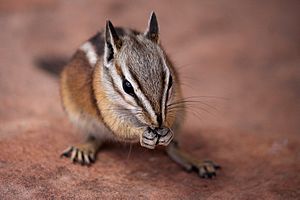Uinta chipmunk facts for kids
Quick facts for kids Uinta chipmunk |
|
|---|---|
 |
|
| Conservation status | |
| Scientific classification | |
| Genus: |
Neotamias
|
| Species: |
umbrinus
|
| Subspecies | |
|
7 (see text) |
|
| Synonyms | |
|
Tamias umbrinus J. A. Allen, 1890 |
|
The Uinta chipmunk, also known as the hidden forest chipmunk (Neotamias umbrinus), is a small, striped animal. It is a type of chipmunk and belongs to the squirrel family, called Sciuridae. This chipmunk lives only in the United States.
Scientists used to call it Tamias umbrinus. But after studying its family tree, they found it was different enough from the eastern chipmunk. So, they put it in its own group, called Neotamias. Some studies even suggest that Palmer's chipmunk might be a type of Uinta chipmunk. However, for now, they are usually seen as separate species.
Contents
About the Uinta Chipmunk
The Uinta chipmunk is a medium-sized chipmunk. Adult chipmunks are about 20 to 24 centimeters (8 to 9.5 inches) long. This length includes their tail, which is about 7 to 11 centimeters (3 to 4.5 inches) long. On average, they weigh about 67 grams (2.4 ounces).
What They Look Like
In summer, their fur can be yellowish-brown-grey to dark brown. It often has a reddish tint. They have three wide, dark blackish-brown stripes down their back. These stripes are separated by four lighter stripes of pale grey or white fur. They also have three dark and three light stripes on each side of their face.
In winter, their fur becomes duller and more greyish. The stripes are not as clear. Their ears are black, and their belly is a very pale grey. Their tail has orange and black fur, with lighter hair underneath.
Where Uinta Chipmunks Live
The Uinta chipmunk lives in mountain forests in the western United States. They are found at high elevations, between 1,400 and 3,650 meters (4,600 and 12,000 feet) high. They like to live at the edges of pine and fir forests or in open areas. They are often found near rocky places or steep hills.
Uinta chipmunks do not live in one big, connected area. Instead, they are found in many separate spots. This might be because forest areas changed a lot during the Ice Age (Pleistocene period).
Different Types of Uinta Chipmunks
There are currently seven recognized types, or subspecies, of the Uinta chipmunk:
- N. u. adsitus - found in southern Utah and northern Arizona
- N. u. inyoensis - found in central Nevada and eastern California
- N. u. fremonti - found in western Wyoming
- N. u. montanus - found in western Colorado
- N. u. nevadensis - found in southern Nevada
- N. u. sedulus - found in southeastern Utah
- N. u. umbrinus - found in northern Utah
Diet and Behavior
Uinta chipmunks are herbivores, which means they mostly eat plants. Their main diet includes seeds from trees like Douglas fir, ponderosa pine, juniper, and spruce. They also eat fruit from local bushes like wild roses, raspberries, and chokecherries. Sometimes, they eat grass and fungi. They might also eat small amounts of insects or dead animals.
Daily Life
These chipmunks are solitary animals, meaning they live alone. They are also diurnal, which means they are active during the day. They can be aggressive towards other chipmunks of their own kind. Each chipmunk defends its own territory, which is about 2 to 5 hectares (5 to 12 acres) in size.
They make their homes in burrows under rocks, bushes, or other shelters. They might also use natural cracks in rocks or hollow logs. They spend much of the winter inside their dens. At other times, they are very good at climbing trees. They climb trees to find food and to escape from predators.
Sounds They Make
Uinta chipmunks make several different sounds. The most common sound is a series of sharp "chip" noises. These sounds can last for up to 15 minutes. They usually make these sounds from high places, like rocky outcrops or tall tree branches. Other sounds include lower-pitched "chuck" noises, which they often mix with "chips" when running from danger. They also make trills and squeals.
Life Cycle and Reproduction
The breeding season for Uinta chipmunks happens in the spring. This is usually from late April to early June. The exact time depends on the weather and how far north they live.
After about 30 days of gestation (when the baby grows inside the mother), the mother gives birth to one litter. A litter usually has three to five young chipmunks. The young chipmunks stop drinking their mother's milk (wean) at around 25 days old. Soon after, they start to leave the burrow.
Only about 27.5% of Uinta chipmunks survive through the winter. It is believed that they live for a maximum of two years.
See also
 In Spanish: Neotamias umbrinus para niños
In Spanish: Neotamias umbrinus para niños


